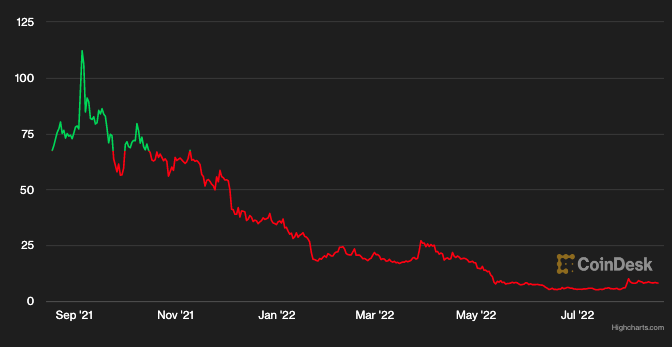Is Filecoin Network’s Incentive Plan Sustainable? Crypto Analysts Want to Know

How long can it last?
That’s what crypto analysts are wondering about the Filecoin incentive program, the driver behind the bulk of the blockchain project’s growth.
Filecoin was launched in 2020 to decentralize the data storage business, providing an alternative to industry giants like Amazon (AMZN) at nearly a thousandth of the cost.
At its core, the network connects storage providers with clients looking to stow their data. By offering storage space – ranging from extra capacity on desktop computers to large racks – and then running mathematical proofs to show that clients’ data is unaltered, providers can earn the network’s native FIL token as a blockchain reward.
Recently, activity has been picked up the pace. According to a Messari report, active Filecoin storage deals between providers and clients surged 128% from the first quarter to the second quarter of 2022.
That has crypto analysts calling attention to the incentive program linked to 99.7% of that growth – Filecoin Plus (Fil+) – and wondering whether it’s sustainable.
Under Fil+, storage providers can earn 10 times the block reward, or amount of FIL tokens, of a typical deal by working with “trustworthy clients” such as universities and research facilities. These clients apply to notaries, or community-elected trustees, to verify the data they are storing.
Fil+’s approval system weeds out storage providers who may negotiate deals with clients storing fake data just to reap block rewards.
Analysts say that Fil+ block rewards act as a subsidy for providers, making it feasible for them to slash storage fees (averaging $0.0000026 per gigabyte per year). Still, they wonder what might happen to Filecoin’s growth and activity once the incentive program tapers off.
“Over time, storage miners will have to start charging,” said Messari enterprise research analyst Sami Kassib. “What I think is going to be the most important thing to watch there is if the storage demand can still keep up when storing data is no longer free.”
New revenue streams
Filecoin project leaders say the network is set to roll out new functions to create additional revenue streams for>
Jonathon Victor, product lead for Protocol Labs, the open-source research and development lab that developed Filecoin, outlined five revenue sources for storage providers: block rewards, storage fees, retrieval fees, transaction fees and additional services.
Storage fees are what clients pay storage providers for the initial storage deal. Retrieval fees are what clients pay providers to fetch stored data. Transaction fees are what crypto brokers charge traders for buying and selling FIL.
While revenue from block rewards will eventually decrease, Victor argues that storage fees will remain low as long as providers can make up the lost revenue through retrieval fees, transaction fees and additional services.
According to Filecoin’s 2022 roadmap, the storage network plans to add a retrieval market during the third quarter that would increase the speed of blockchain data retrieval and allow storage providers to charge clients for retrieving the data they are storing.
Filecoin also launched the Filecoin Virtual Machine (FVM) in July 2022, which let clients run smart contracts from other networks and unlocked the potential for decentralized finance (DeFi).
In the fourth quarter of this year, Filecoin plans to implement a programmable storage market, which would allow clients to create customized smart contracts to meet their needs.
“Things like the FVM are going to drive transaction fees,” said Victor. “It will drive demand for Filecoin block space.”
FIL token price

Filecoin’s FIL token price is well off its highs over the past year. (CoinDesk)
Additional services that will generate revenue for storage providers include on-chain and off-chain computing functions, which Filecoin plans to add to allow clients to use their stored data for calculations. On-chain computing is done through smart contracts on the blockchain while off-chain computing temporarily takes data off of the blockchain.
One key question for digital-asset traders is what these changes all mean for the project’s FIL token, which has more than doubled in price from a low point in June to a two-month high around $11.37 on Aug. 1.
The token is now trading at around $8.21, which is still about 96% down from its all-time high.
“What Protocol Labs’ main goal is, is to maintain and to increase block space demand,” Kassib said. “As long as you’re doing that, then the FIL token continues to accrue value, which continues to incentivize the storage providers and all the other supply-side participants in the network.”







 Bitcoin
Bitcoin  Ethereum
Ethereum  Tether
Tether  USDC
USDC  Dogecoin
Dogecoin  Cardano
Cardano  TRON
TRON  Bitcoin Cash
Bitcoin Cash  Chainlink
Chainlink  Polygon
Polygon  Litecoin
Litecoin  LEO Token
LEO Token  Dai
Dai  Ethereum Classic
Ethereum Classic  Stacks
Stacks  Cronos
Cronos  OKB
OKB  Stellar
Stellar  Cosmos Hub
Cosmos Hub  Hedera
Hedera  Maker
Maker  Monero
Monero  Theta Network
Theta Network  Algorand
Algorand  NEO
NEO  Synthetix Network
Synthetix Network  Tezos
Tezos  Gate
Gate  EOS
EOS  KuCoin
KuCoin  IOTA
IOTA  Tether Gold
Tether Gold  Bitcoin Gold
Bitcoin Gold  TrueUSD
TrueUSD  Enjin Coin
Enjin Coin  Zilliqa
Zilliqa  0x Protocol
0x Protocol  Ravencoin
Ravencoin  Qtum
Qtum  Holo
Holo  Siacoin
Siacoin  Basic Attention
Basic Attention  Dash
Dash  Decred
Decred  NEM
NEM  Zcash
Zcash  Ontology
Ontology  Waves
Waves  Lisk
Lisk  DigiByte
DigiByte  Numeraire
Numeraire  Status
Status  Nano
Nano  Hive
Hive  Pax Dollar
Pax Dollar  Steem
Steem  Huobi
Huobi  OMG Network
OMG Network  BUSD
BUSD  Ren
Ren  Bitcoin Diamond
Bitcoin Diamond  Bytom
Bytom  HUSD
HUSD  Kyber Network Crystal Legacy
Kyber Network Crystal Legacy  Energi
Energi  Augur
Augur